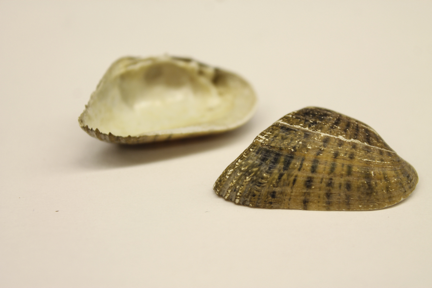Purple Wartybacks, Pink Heelsplitters, and Rayed Beans—Oh my!

Text and Photos by Vanessa Minke-Martin, EVC Student
Freshwater mussels live in streams and lakes across the country, but the largest number of species and highest densities of Canadian mussels are found in the rivers of southern Ontario. Unfortunately, thirteen of the 41 species currently living in Ontario are at risk of disappearing from our waters.
The ROM has an impressive collection of freshwater mussel shells, some of which are on display in the Schad Gallery of Biodiversity. The collection includes shells from more than 65 different species, some dating back to the mid 1800’s. The collection is still growing, and the newest specimens were added in 2012. The ROM has mussel tissues or shells from Canada, Australia, England, Germany and USA. All of Ontario’s species are represented.
On one side of the Earth Rangers Studio, there is a grouping of four mussel shells on display. These species are extinct, meaning they can no longer be found alive anywhere on Earth.

North America has the highest freshwater mussel biodiversity in the world: almost 300 different species can be found here. Still, mussels are in trouble. They are the most imperiled group of plant or animal on the continent. Almost 75% of North American mussel species are recently extinct or currently at risk of going extinct.
Invertebrate Zoology Curator Dr. Claire Healy and Technician Maureen Zubowski took me behind-the-scenes to see some of the freshwater mussel specimens in the ROM collection.
Some of the species, like the Snuffbox, are extremely rare. Although Snuffbox mussels once lived in five major Ontario rivers and two of the Great Lakes, they are now only found in the Ausable and Sydenham Rivers in southern Ontario.

Freshwater mussels spend most of their lives buried in streambeds, unable to move more than a few metres. Human activities, like damming and dredging rivers and polluting freshwater reduce suitable habitat and expose mussels to chemicals and toxins. Invasive species, like the Zebra Mussel, also threaten native mussel species.

Protecting freshwater mussels species must take into account their complex life cycle. Young mussels spend the first few weeks of their lives as parasites on fish. This life stage provides necessary sustenance for young mussels before they develop into adults. By traveling on the bodies of their fish hosts, mussels colonize new habitats within the river, which they could never reach as adults.
There are different strategies that female mussels use to ensure their young successfully parasitize a host. The Snuffbox mussel has one primary host fish: the Logperch. Researchers have observed the female Snuffbox trapping the nose of a Logperch between her shells! At the same time, she releases her young directly onto the Logperch, and they attach to the fish’s gills and fins.

You can watch a video of a Snuffbox mussel catching a Logperch here.
Freshwater mussels are an important part of river ecosystems. They filter water, provide habitat on their shells for algae, and act as a food source for animals, such as muskrats. In order to protect these species from extinction, we need to protect river habitat and fish species and keep our waters clean.
If you would like to learn more about Canada’s freshwater mussels, download the Canadian Freshwater Mussel Guide mobile app on iTunes.
